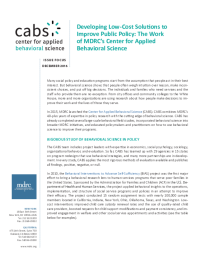Developing Low-Cost Solutions to Improve Public Policy
The Work of MDRC’s Center for Applied Behavioral Science

Many social policy and education programs start from the assumption that people act in their best interest. But behavioral science shows that people often weigh intuition over reason, make inconsistent choices, and put off big decisions. The individuals and families who need services and the staff who provide them are no exception. From city offices and community colleges to the White House, more and more organizations are using research about how people make decisions to improve their work and the lives of those they serve.
In 2015, MDRC launched the Center for Applied Behavioral Science (CABS). CABS combines MDRC’s 40-plus years of expertise in policy research with the cutting edge of behavioral science. CABS has already completed several large-scale behavioral field studies, incorporated behavioral science into broader MDRC initiatives, and educated policymakers and practitioners on how to use behavioral science to improve their programs.
Rigorous Study of Behavioral Science in Policy
The CABS team includes project leaders with expertise in economics, social psychology, sociology, organizational behavior, and evaluation. So far, CABS has teamed up with 29 agencies in 15 states on program redesigns that use behavioral strategies, and many more partnerships are in development. In every study, CABS applies the most rigorous methods of evaluation available and publishes all findings, positive, negative, or null.
In 2010, the Behavioral Interventions to Advance Self-Sufficiency (BIAS) project was the first major effort to bring a behavioral research lens to human services programs that serve poor families in the United States. Sponsored by the Administration for Families and Children (ACF) in the U.S. Department of Health and Human Services, the project applied behavioral insights to the operations, implementation, and structure of social service programs and policies in an attempt to improve their efficacy. The project conducted 15 random assignment tests with nearly 100,000 sample members located in California, Indiana, New York, Ohio, Oklahoma, Texas, and Washington. Low-cost interventions improved child care subsidy renewal rates and the use of quality-rated child care providers, boosted requests for child support modifications and payment consistency, and improved engagement in welfare and other social service appointments and activities (see the table below for examples).
|
Site |
Outcome |
Intervention Cost Per Person |
|
Increased requests for order modifications by incarcerated parents to 41.3 percent, a 31.9 percentage point increase |
$10.46 |
|
|
Increased parent attendance at their first scheduled subsidy renewal appointments to 54.7 percent, a 10.6 percentage point increase |
$2.79 |
|
|
Increased meeting attendance for a tax credit program to 28.5 percentage, a 12 percentage point increase |
$1.75 |
Building on these findings, CABS has continued a partnership with ACF on two more projects: Behavioral Interventions for Child Support Services (BICS) and BIAS Next Generation. The BICS project launched tests in seven states and the District of Columbia in 2016, while BIAS Next Generation will begin testing in 2017.
Integrating Behavioral Science into Broader Policy Research
Beyond behaviorally focused studies, MDRC is also incorporating behavioral insights learned through CABS into studies of more traditional social policy interventions. As a result, CABS and MDRC are finding new ways to improve the strategy and efficacy of social policy and education research.
For example, with the Center for Economic Opportunity in New York City, MDRC is testing an expansion of the Earned Income Tax Credit (EITC) for single working adults. The Paycheck Plus program randomly assigned 6,000 single low-wage workers without a dependent child to be eligible to receive a $2,000 maximum benefit, four times the current federal EITC. This study could serve as a model for supporting low-wage work by expanding the EITC nationwide. A behavioral sub-study of Paycheck Plus assessed the most effective ways of increasing study participants’ knowledge and engagement with the program, evaluating various messaging and design approaches for reminders to attend an informational meeting. In so doing, Paycheck Plus will not only test the impact of the expanded EITC but also help determine the best ways to engage low-income adults in a social program.
Similarly, MDRC recently launched the Incentivizing Continual Enrollment (ICE) project in Ohio with the support of the Great Lakes Higher Education Corporation. This effort is intended to increase the number of community college students who enroll in courses during the summer term and, ultimately, complete their degrees. The project will test financial aid incentives and behavioral messaging interventions designed by CABS.
Expanding the Use of Behavioral Science in Organizations Nationwide
Going beyond research, CABS also aims to empower frontline agencies to learn and apply behavioral science themselves through a combination of presentations, workshops and trainings, and collaborative projects.
For example, MDRC has worked extensively with New York City’s Human Resources Administration to incorporate behavioral science techniques into their programs and communications. The Nudges to Increase Customer Engagement (NICE) project designed behavioral interventions to increase parent engagement in an administrative process for establishing child support orders and improve ongoing communication between the child support program and its clients. This past summer, CABS provided a full-day workshop for their staff on ways to build on and expand that work.
CABS also recently conducted a virtual learning series for nine community colleges and workforce development organizations participating in the Health Profession Opportunity Grants (HPOG) program administered by the Administration for Children and Families. The curriculum focused on the behavioral science concepts and methods of diagnosis and design that are the foundation for behaviorally informed policy and practice. During the two-month series, grantee staff actively applied the lessons to their organizations’ operations in order to identify potential behavioral bottlenecks and solutions.
Follow MDRC’s Behavioral Work
Behavioral interventions in social policy and education programs have the unique potential to positively affect large numbers of people at very low cost. Many of these interventions may simply increase the reach of a program that is already doing well or make it easier for people to access the resources that would make a difference in their lives. The increasing use of behavioral science across public and nonprofit agencies holds the promise of contributing to the well-being of low-income populations across the country. Follow us on Twitter @CABS_MDRC and sign up for the Behavioral Buzz newsletter to receive quarterly updates on MDRC’s ACF-funded research.
This article first appeared on the blog of the Behavioral Science and Policy Association.






